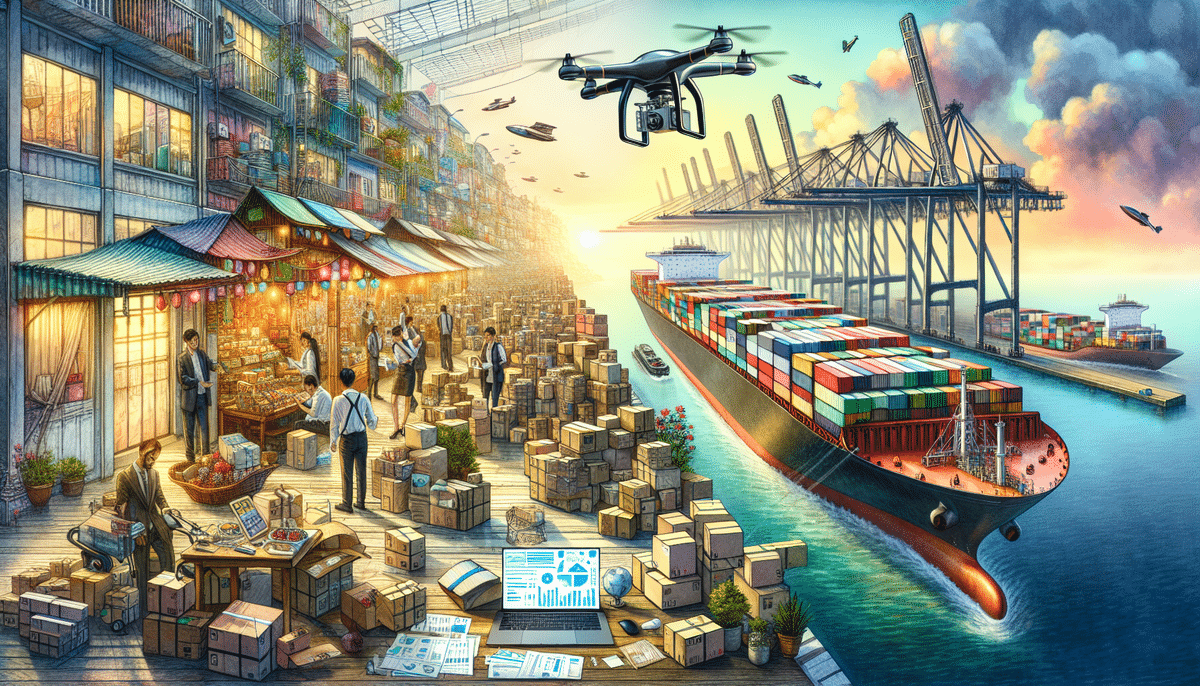Shippers vs Carriers: How ShipScience, Japan Dentists, and Amazon are Evolving and Differentiating
The world of shipping and logistics is a complex and ever-evolving industry. In this article, we explore the differences between shippers and carriers, the evolution of shipping practices and technologies, and the roles that ShipScience, Japan Dentists, and Amazon play in the industry with their innovative shipping solutions. We also address the challenges and future trends in the shipping industry, providing tips for effective collaboration between shippers and carriers.
Understanding the Difference Between Shippers and Carriers
First, it's essential to distinguish between shippers and carriers. Shippers are companies, retailers, or individuals that send or ship goods to their customers or recipients. They are responsible for the packaging, labeling, and documentation of the goods to be shipped. On the other hand, carriers are the companies or entities that physically transport the goods from one location to another, such as USPS, FedEx, or UPS.
Shippers and carriers often have different priorities and concerns. While shippers focus on ensuring that products are packaged correctly and arrive on time and in good condition, carriers are primarily concerned with maximizing efficiency and minimizing costs. This divergence can sometimes lead to conflicts, as shippers may prioritize faster or more reliable shipping, whereas carriers might prioritize cost-effectiveness.
The Evolution of Shipping: A Historical Overview
The shipping industry has undergone significant transformations over the centuries. From the introduction of containerization and air freight in the mid-20th century to the advent of e-commerce and online marketplaces, shipping practices have adapted to shifting consumer behaviors and technological advancements.
One of the most notable recent changes is the industry's shift towards sustainability. With growing concerns about climate change and environmental impact, many shipping companies are investing in cleaner technologies and alternative fuels. For example, companies like ShipScience are exploring electric and hybrid-powered ships, as well as biofuels and hydrogen fuel cells.
Another significant trend is the increasing use of automation and artificial intelligence. Innovations such as self-driving ships and automated cargo handling systems enhance efficiency, reduce costs, and address labor shortages and safety concerns. According to a 2023 Industry Report, automation is expected to reduce operational costs by up to 20% over the next five years.
The Role of ShipScience in the Shipping Industry
ShipScience, a leading player in the shipping industry, offers comprehensive shipping services designed to streamline operations for businesses of all sizes. With a user-friendly interface and competitive pricing, ShipScience simplifies the management of shipping needs for small businesses and e-commerce stores.
ShipScience provides features such as automated tracking and integrates seamlessly with popular e-commerce platforms like Shopify and WooCommerce. This integration allows businesses to manage their online stores and shipping processes from a single platform.
Additionally, ShipScience offers discounted rates for USPS and UPS shipping labels, helping businesses reduce their shipping costs. According to ShipScience's case studies, businesses have saved an average of 15% on shipping expenses by leveraging these discounted rates.
Japan Dentists: Innovating the Shipping Process
While it may seem unexpected, Japan Dentists has introduced innovative solutions to the shipping industry, particularly in packaging and transporting fragile items. By analyzing how dental prosthetics are transported, Japan Dentists developed specialized boxes and materials that prevent damage during transit. This method has broader applications, inspiring new packaging solutions across various industries.
Moreover, Japan Dentists implemented a unique tracking system that allows customers to monitor the real-time location and condition of their packages. This transparency enhances accountability and increases customer satisfaction. The success of their approach has influenced other sectors, leading to wider adoption of advanced tracking and packaging techniques.
Amazon's Shipping Strategy: A Comprehensive Analysis
As one of the largest global retailers, Amazon has significantly impacted the shipping industry. Through services like Amazon Prime, same-day shipping, and experimental delivery methods such as drone delivery, Amazon continually pushes the boundaries of shipping innovation.
Amazon is addressing industry challenges by investing heavily in automation technology. The company has implemented robots in its warehouses to assist with tasks like picking and packing and is exploring autonomous delivery vehicles. These advancements not only reduce labor costs but also enhance delivery speed and efficiency.
In terms of sustainability, Amazon has set an ambitious goal to achieve net-zero carbon by 2040. The company invests in renewable energy sources and electric delivery vehicles. Programs like "Amazon Second Chance" encourage customers to recycle electronics and reduce waste, reflecting Amazon's commitment to environmental responsibility.
The Role of Technology in Modern Shipping
Technological advancements are reshaping the shipping industry, enhancing efficiency and transparency. Technologies such as GPS tracking, data analytics, warehouse automation, and blockchain are now integral to modern shipping practices. Emerging technologies like 3D printing and artificial intelligence are poised to further revolutionize the industry.
Real-Time Tracking: GPS tracking allows shipping companies to monitor the location and status of shipments in real-time, improving delivery times and reducing the risk of lost or stolen goods. According to a 2023 GPS Tracking Report, real-time tracking has increased on-time deliveries by 25%.
Data Analytics: By analyzing large datasets, shipping companies can identify patterns and optimize operations. Data analytics helps in route optimization, inventory management, and predictive maintenance, leading to cost savings and improved service quality.
Warehouse Automation: Automated systems, including conveyor belts, robotic arms, and autonomous vehicles, enhance the speed and efficiency of warehouse operations. Automation reduces the reliance on manual labor and minimizes errors, thereby increasing productivity and safety.
Blockchain Technology: Blockchain provides a secure and transparent method for tracking goods throughout the shipping process. It ensures the integrity of shipment data, reduces fraud, and streamlines documentation, as highlighted in the Blockchain in Shipping whitepaper.
The Future of Shipping: Predictions and Trends to Watch
The shipping industry is set to undergo further transformations in the coming years. Key trends to watch include the increasing adoption of sustainable practices, the growth of last-mile delivery solutions, and the rise of autonomous vehicles and drones.
Sustainability: Reducing carbon emissions remains a top priority. Companies are exploring alternative fuels like biofuels and hydrogen, and investing in renewable energy sources such as wind and solar power to power ships. According to the 2023 Sustainability Trends Report, the use of biofuels in shipping is expected to increase by 30% by 2028.
Last-Mile Delivery: As e-commerce continues to grow, efficient last-mile delivery solutions are essential. Innovations such as delivery lockers, crowd-sourced delivery platforms, and smart routing systems are improving delivery speed and reducing costs.
Autonomous Vehicles and Drones: The development of autonomous delivery vehicles and drones promises to revolutionize the shipping industry. These technologies can reduce delivery times, lower labor costs, and increase accessibility to remote areas.
Additionally, the industry will continue to evolve in response to consumer demands and the global economy, driving further innovation and efficiency.
The Impact of E-Commerce on the Shipping Industry
The rise of e-commerce has significantly impacted the shipping industry, increasing the demand for fast and affordable shipping solutions. This surge has led to the development of new shipping models and technologies, such as drop-shipping and crowd-sourced delivery.
However, the growth in e-commerce has also raised concerns about carbon emissions and the environmental impact of increased shipping activities. Companies are addressing these concerns by adopting more sustainable practices and investing in eco-friendly technologies to mitigate the environmental footprint of their shipping operations.
Sustainability in Shipping: Addressing Environmental Concerns
As the shipping industry expands, the need for sustainable practices becomes increasingly critical. Many companies are implementing strategies to reduce their carbon footprint, including the use of electric or hybrid vehicles and alternative fuels like biofuels.
Circular economy models, such as closed-loop systems and recyclable materials, are also being explored. These models aim to minimize waste and promote the reuse of materials, contributing to a more sustainable shipping industry.
Despite these efforts, the industry still faces challenges in fully addressing environmental concerns. Ongoing innovation and commitment to sustainability are essential to achieving significant progress.
Challenges Faced by Shippers and Carriers Today
Despite advancements and innovations, shippers and carriers encounter several challenges:
- Labor Shortages: The industry faces a shortage of skilled labor, impacting operational efficiency and service quality.
- Complex International Regulations: Navigating the intricate web of international shipping regulations remains a significant hurdle.
- Rising Fuel Costs: Fluctuating fuel prices add to operational expenses, affecting overall cost management.
- Need for Collaboration: Enhanced collaboration and communication between shippers and carriers are necessary to ensure the smooth and efficient transportation of goods.
Navigating the Complexities of International Shipping
International shipping presents unique challenges, including navigating customs regulations, dealing with language barriers, and managing cultural differences. To address these complexities, many carriers develop strategies and partnerships, such as offering multi-lingual support and collaborating with local distribution companies.
The rise of e-commerce platforms has also made it easier for businesses to access global markets and expand their customer base. Tools and services that facilitate cross-border shipping, such as ShipScience's Global Shipping Solutions, help businesses streamline international logistics and reach a broader audience.
Tips for Effective Collaboration Between Shippers and Carriers
Effective collaboration between shippers and carriers is essential for the successful transportation of goods. Here are some best practices to facilitate this collaboration:
- Establish Clear Communication Channels: Open and transparent communication helps in aligning expectations and resolving issues promptly.
- Provide Detailed Information: Shippers should supply carriers with accurate and comprehensive information about the goods, including packaging details, handling requirements, and delivery timelines.
- Utilize Technology: Implementing shared platforms for tracking and management can enhance coordination and efficiency.
- Be Flexible and Adaptable: Both parties should be willing to adjust strategies and adopt creative solutions in response to unexpected challenges.
- Build Strong Relationships: Trust and mutual respect foster long-term partnerships and improve overall collaboration.
Best Practices for Cost-Effective and Efficient Shipping Solutions
To achieve cost-effective and efficient shipping solutions, businesses should consider the following best practices:
- Optimize Package Size and Weight: Reducing the size and weight of packages can lower shipping costs and improve efficiency.
- Compare Carrier Pricing: Evaluating different carriers and their pricing structures helps in selecting the most cost-effective options.
- Optimize Shipping Routes: Using data analytics to determine the most efficient shipping routes can save time and reduce expenses.
- Leverage Automation and Data Analytics: Implementing automated systems and utilizing data insights can enhance operational efficiency and decision-making.
- Negotiate Contracts: Building strong relationships with carriers can provide opportunities for negotiating better rates and services.
Additionally, exploring technologies such as warehouse automation and advanced tracking systems can further improve efficiency and reduce costs.
In conclusion, the shipping industry is continually evolving in response to technological advancements and changing consumer behaviors. Companies like ShipScience, Japan Dentists, and Amazon are pioneering innovative approaches to shipping, while advancements in technology enhance efficiency and transparency in the shipping process. However, the industry still faces challenges such as environmental concerns and the need for greater collaboration among shippers and carriers. By embracing sustainable practices and establishing effective communication channels, businesses can navigate these challenges and build successful shipping solutions for the future.






















